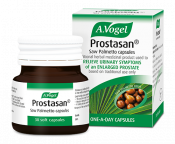An introduction to the treatment available for the enlarged prostate
There are a variety of ways of treating prostate enlargement (BPH). Decision on the best treatment for each individual depends on how long your prostate has been enlarged and the level of prostate symptoms you are experiencing.
In general, the following treatment options are used:
- Watch and wait. This is the option for mild cases with few symptoms
- Prescribed medication. Used for moderate or troublesome symptoms and before surgery is considered
- Surgery. Used for moderate or severe symptoms, ranging from minimally invasive to open surgery
- Herbal remedies. Whilst not always accepted by the medical profession, Saw Palmetto herb is increasingly being considered as an option by doctors, including urologists.
Your doctor should be in a position to discuss the range of options and offer advice on which option is best suited to you.
Watch and wait
Known by doctors as 'watchful waiting', it is the treatment of choice for men with few or no symptoms, or symptoms which do not interfere with their daily lives. It is not about ignoring the problem.
Even when the prostate gland is confirmed to be enlarged, the level of symptoms experienced might vary from day to day and these can sometimes disappear if left alone, for months or years.
With watchful waiting, the patient is asked to report back to the doctor if mild symptoms worsen. In this way, symptoms become ‘worth treating’ – the cost of treatment in terms of risks and side-effects will be outweighed by the benefits.
If symptoms worsen, the patient will generally be advised to move onto one of the prescribed medicines used for prostate enlargement.
Prescribed medicines
Prescription drugs may be recommended by your doctor if your enlarged prostate symptoms are of moderate severity. These generally belong to two classes (types) of medicines:
- 5α-reductase inhibitors (eg. finasteride, dutasteride, Proscar). These work as antiandrogens, decreasing the amount of 5α-reductase in the body
- α-blockers (eg. tamsulosin, alfuzosin, Flomax). These work by blocking receptors and nerve impulses, relaxing muscles in the prostate and bladder
Both of these drug treatments reduce symptoms by interfering with the chemical pathways leading to prostate enlargement. They are well-known to doctors and urologists, widely used, but can have the tendency to give rise to a variety of side effects.
Surgery
This is the option considered when a man is unable to tolerate prescribed medication, if symptoms worsen or are severe. With modern technology, prostate surgery has become increasingly less invasive and there are now a variety of methods of treating an enlarged prostate using fibre optic cameras, with few or no incisions made in the abdomen.
The main types of surgery used are:
- Trans-urethral resection of prostate (TURP). The prostate is removed using a small instrument (with attached camera) introduced through the penis
- Trans-urethral incision of prostate (TUIP). Here the same instrument is used to make small cuts in the prostate and urethra. It is used when severe symptoms are caused by a small prostate
- Trans-urethral microwave thermotherapy (TUMT). Unlike TURP or TUIP which uses a small scalpel, this method applies heat to prostate tissue, causing cell death
- Trans-urethral needle ablation (TUNA). Just as with TUMT, this destroys prostate tissue using heat – but instead of microwaves, high frequency radio waves are used
- Open prostatectomy. This is conventional surgery where the prostate is removed following an incision made in the lower abdomen.
- Prostate Artery Embolization. This involves blocking some of the arteries that feed the prostate to reduce blood blood flow and shrink the gland.
Herbal remedies
An alternative to watchful waiting is the use of Saw Palmetto products licensed for the treatment of enlarged prostate symptoms.
These herbal extracts have the advantage of not being associated with the level of side effects seen with prescribed medicines for the prostate. Saw Palmetto extracts are available without prescription from many high street outlets so are a convenient form of treatment to try. The only requirement is that the diagnosis of an enlarged prostate has been confirmed by your doctor.
Saw Palmetto extracts can be used at the watchful waiting stage, at any level of symptom severity, before or after surgery. However, they may not be used if you are already on conventional or prescribed medicines for your prostate.








